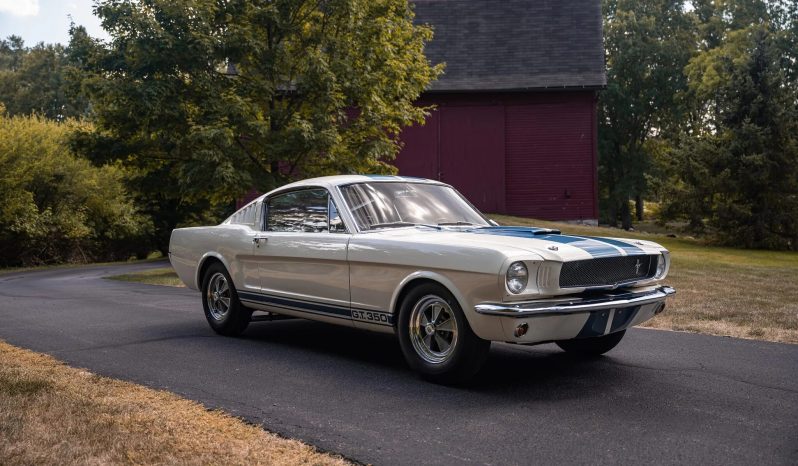This 1965 Shelby Mustang GT350 is one of 504 street production examples built for the model year during the first seven months of construction of Shelby American’s Mustang variant. Chassis SFM5S459 was completed at Shelby’s Los Angeles facility on June 28, 1965. Finished in Wimbledon White over black vinyl, the car is powered by a 289ci HiPo V8 mated to a Borg-Warner T10 four-speed manual transmission and a Detroit Locker differential. Additional equipment includes a four-barrel Holley carburetor on a high-rise intake manifold, Kelsey-Hayes ventilated front disc brakes, Koni shock absorbers, rear overrider traction bars, dual side-exit exhaust, a front-mounted battery, a fiberglass rear package tray, and a dash-mounted tachometer.
The 289ci Windsor V8 was shared with K-code Mustangs and was topped with a four-barrel Holley 715-cfm carburetor and a cast-aluminum high-rise intake manifold to produce a factory-rated 306 horsepower in street versions of the GT350.
Additional GT350-specific features include a finned aluminum “T” oil pan with hinged baffles, open-letter valve covers, and tri-Y exhaust headers leading to exit pipes ahead of each rear wheel.
The Borg-Warner T10 four-speed manual transmission incorporates an aluminum housing and close-ratio gears and sends power to the rear wheels via a 9” rear end with a Detroit Locker differential.
Suspension characteristics distinguishing the GT350 from regular Mustangs include lowered front control arms, a 1” front sway bar, overrider rear traction bars anchored inside the cabin, and Koni shock absorbers all around.
Shelby also utilized longer pitman and idler arms than those used on standard Mustangs.
Development of the GT350 model began in summer 1964 after Ford enlisted Carroll Shelby to create a variant of the Mustang to homologate for competition in the SCCA’s B Production class.
Incomplete K-code Mustang fastbacks were sent from Ford’s San Jose, California, plant to Shelby’s Venice facility for transformation into GT350 specification under the lead of project engineer Chuck Cantwell.
In early 1965, Shelby began shifting production from Venice to its facilities near Los Angeles International Airport.
All 1965 GT350s were finished in Wimbledon White with Guardsman Blue rocker-panel stripes, and this example was delivered to original consignee Tasca Ford with optional blue Le Mans stripes.
Features include a steel-framed fiberglass hood with a functional scoop and quick-release pins, a mesh grille with an offset running-horse logo, sail-panel louvers, and a bullet-style driver-side mirror.
Cragar cast alloy wheels are wrapped with 7.75-15 Goodyear Blue Dot tires, as is a matching spare that is secured atop the fiberglass package shelf in the cargo area.
Kelsey-Hayes front disc brakes incorporate ventilated rotors while 2.5”-wide drums handle braking at the rear.
The cabin is trimmed in black vinyl over low-back bucket seats with color-keyed door panels, carpeting, and rubber floor mats.
Additional features of the 1965 GT350 model include 3” aircraft-style lap belts and a fiberglass rear shelf in lieu of the standard Mustang’s rear seats.
The wood-rimmed steering wheel features slotted spokes and sits ahead of a horizontal-sweep 120-mph speedometer flanked by gauges monitoring fuel level and coolant temperature.
A central two-gauge pod housing an oil-pressure gauge and a tachometer was among the equipment distinct to the Shelby-built Mustangs.
The tachometer was rebuilt in 2017.
The five-digit odometer shows 33k miles.













































































































































